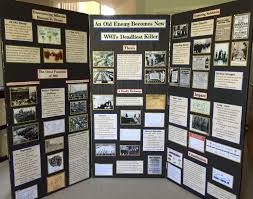
A winning exhibit about World War I’s Deadliest Killer – Spanish Influenza. Taking a stand about the pandemic was vital to world history.
Last week I had the honor and privilege of being a judge for the Regional National History Day contest. This is an event that is close to my heart. I have been involved since 1993, as a parent, a coach, and a judge.
National History Day gives students the opportunity to learn about the research process, about presenting their research in a number of different venues, about gaining poise while speaking to an unknown audience, and accepting constructive criticism. Some of the contestants will go on to become historians; while the majority will be engineers, lawyers, accountants, teachers, and doctors. The skills learned in research will last a lifetime, if used regularly.
Each year the National History Day officers choose a new theme. This year it was Taking a Stand in History. Students were to consider the risk involved in a firm position using force, words or economic power.
Normally there are five venues for students to present their research. The most popular is the exhibits category. They must determine the most important aspects and create visual materials to instruct the audience and judges. As a judge, it is easy to see who spent weeks or months on the project and who put it together the weekend before.
Another format is drama. An individual or group puts together a monologue or play interpreting an event that reflects the theme. Here again, the secret is to be relevant and succinct.
Some students choose to work alone by writing a paper. Judging the three high school students’ works I was amazed with their understanding of the theme. Then there are two venues that would overwhelm me if I were a contestant. One is Documentaries and the other is Websites. These students must have a great understanding of electronics; but most are superior. A documentary is really a short news piece with outstanding interpretation of the theme. Often both documentaries and websites jolt the judges into perceiving a concept in a new light. One of the websites really got me to thinking.
That was Doomsday: the Stand for Freedom, created by two young men. To them Doomsday was June 6, 1944 or D-Day, when allied troops invaded Normandy. For them, the risk-takers were not the soldiers but the generals and admirals who planned the invasion, who had to live with the anxiety and loss of men for the rest of their lives. It was truly a different viewpoint.
The other two websites were equally insightful. Martin Luther King, Jr. and Winston Churchill: Standing Against the New World Order focused on the courage of individual leaders who were often forsaken and ignored. All three websites were almost flawless, especially for high school students.
Three papers dealt with familiar topics in an unfamiliar way. Students examined Rosa Parks, Martin Luther, and Malcolm X and their accomplishments closely. Each pointed out a new twist to a familiar story.
Two students or two teams in each category will travel to Austin in late April to compete in the Statewide National History Day contest. Winners there will present in Washington, D. C. early in June. But every student is really a winner. They researched, presented their research, and did so with poise. That is truly an accomplishment for any student. Congratulations to all.
